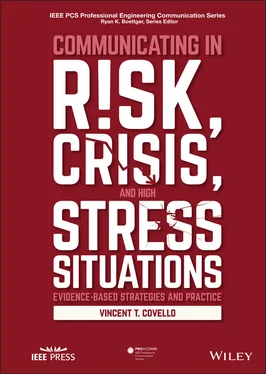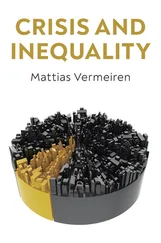8 Include a discussion of risk‐reduction and control actions, including what people can do to increase feelings of self‐efficacy and control or reduce their exposures to risks.
9 Promise only what you can deliver with confidence and do what you promise; guarantee processes rather than outcomes.
Research and analysis of case studies have shown that these principles and guidelines form the basic building blocks for effective risk communication. Each principle and guideline recognizes (differently) that effective risk communication is a process based on mutual trust, stakeholder engagement, and respect. Each principle and guideline also recognize that effective risk communication is central to informed decision‐making and is a complex art and skill that requires substantial knowledge, training, and practice.
3.6 Key Takeaway Concepts and Conclusions from this Overview Chapter
1 Risk communication is a science‐based discipline.
2 High concern situations change the rules of communication.
3 The key to risk communication success is anticipation, preparation, and practice (APP).
4 Opinions about a risk or threat not addressed effectively can morph into unchangeable beliefs.
5 People under stress:have difficulty hearing, understanding, and remembering informationwant to know that you care before they care what you knowfocus much more on negative informationfocus most of what they hear first and lastprocess information well below their educational levelactively seek out additional sources of information to reduce stress and risks,
Below are additional resources to expand on the content presented in this chapter.
1 Árvai, J., and Rivers, L. III., eds. (2014). Effective Risk Communication. London: Earthscan.
2 Arvai, J., and Campbell‐Arvai, V. (2014). “Risk Communication: Insights from the Decision Sciences.” in Effective Risk Communication, eds. J. Arvai and L. Rivers III. London: Taylor and Francis.
3 Andrews, R. (1999). Managing the Environment, Managing Ourselves: A History of American Environmental Policy. New Haven: Yale University Press.
4 Aufder Heide, E. (2004). “Common misconceptions about disasters: Panic, the “disaster syndrome,” and looting,” in The First 72 Hours: A Community Approach to Disaster Preparedness, ed. M. O’Leary. Lincoln, NB: iUniverse Publishing.
5 Beck, U. (1992). Risk Society: Towards a New Modernity. Los Angeles, CA: Sage Publications.
6 Beck, M., and Kewell, B. (2014). Risk: A Study of Its Origins, History and Politics. New Jersey: World Scientific Publishing Company.
7 Becker, S. (2004). Emergency communication and information issues in terrorist events involving radioactive materials. Biosecurity and Bioterrorism: Biodefense Strategy, Practice, and Science 2(3):195–207.
8 Bennett, P., and Calman, K., eds. (1999). Risk Communication and Public Health. New York: Oxford University Press.
9 Bennett, P., Coles, D., and McDonald, A. (1999). “Risk communication as a decision process,” in Risk Communication and Public Health, eds. P. Bennett and K. Calman. New York: Oxford University Press.
10 Bier, V.M. (2001). “On the state of the art: risk communication to the public.” Reliability Engineering and System Safety 71(2):139–150.
11 Bohnenblust, H., and Slovic, P. (1998). “Integrating technical analysis and public values in risk based decision making.” Reliability Engineering & System Safety 59:151–159.
12 Boholm, Å. (2019). “Risk communication as government agency organizational practice.” Risk Analysis ( 39)8:1695–1707.
13 Boin, A., Rhinard, M., and Ekengren, M. (2014). “Managing transboundary crises: the emergence of European Union Capacity.” Journal of Contingencies and Crisis Management 22(3):131–142.
14 Boin, A., Hart, P., Stern, E. and Sundelius, B. (2005). The Politics of Crisis Management: Public Leadership Under Pressure. Beverly Hills, CA: Sage.
15 Bostrom, A. (2003). “Future risk communication.” Futures 35:553–573.
16 Bostrom, A., Atman, C., Fischhoff, B., and Morgan, M.G. (1994). “Evaluating risk communications: completing and correcting mental models of hazardous processes, Part II.” Risk Analysis 14 (5):789–797.
17 Breakwell, G.M. (2007). The Psychology of Risk. Cambridge, UK: Cambridge University Press.
18 Centers for Disease Control and Prevention (2019). Crisis and Emergency Risk communication. Atlanta, GA: Centers for Disease Control and Prevention.
19 Chess, C., Hance, B.J., and Sandman, P. M. (1986). Planning Dialogue with Communities: A Risk Communication Workbook. New Brunswick, NJ: Rutgers University, Cook College, Environmental Media Communication Research Program.
20 Chess, C., Hance, B.J., and Sandman, P.M. (1988). Improving Dialogue with Communities: A Short Guide to Government Risk Communication. Trenton, NJ: New Jersey Department of Environmental Protection.
21 Chess, C., Hance, B.J., and Sandman, P.M. (1989). Planning Dialogue with Communities. A Risk Communication Workbook. New Brunswick, NJ: Rutgers University, Cook College, Environmental Communication Research Program.
22 Chess, C., Salomone, K.L., and Hance, B.J. (1995). “Improving risk communication in government: research priorities.” Risk Analysis 15 (2):127–135.
23 Chess, C., Salomone, K.L., Hance, B.J., and Saville, A. (1995). “Results of a national symposium on risk communication: next steps for government agencies.” Risk Analysis 15 (2):115–120.
24 Cvetkovich, G., Vlek, C.A., and Earle, T.C. (1989). “Designing technological hazard information programs: towards a model of risk‐adaptive decision making,” in Social Decision Methodology for Technical Projects, eds. C.A.J. Vlek, G. Cvetkovich. Dordrecht: Kluwer Academic.
25 Coombs, W.T. (1998). “An analytic framework for crisis situations: Better responses from a better understanding of the situation.” Journal of Public Relations Research 10(3):177–192.
26 Coombs, W. (1999). Ongoing Crisis Communications: Planning, Managing, and Responding. Thousand Oaks, CA: Sage Publications, Inc.
27 Coombs, W.T. (2007). “Protecting organization reputations during a crisis: The development and application of situational crisis communication theory.” Corporate Reputation Review 10(3):163–176.
28 Covello, V. (1992). “Risk communication, trust, and credibility.” Health and Environmental Digest 6(1):1–4.
29 Covello, V. (1993). “Risk communication, trust, and credibility.” Journal of Occupational Medicine 35:18–19.
30 Covello, V.T (1993). “Risk communication and occupational medicine.” Journal of Occupational Medicine 35:18–19.
31 Covello, V.T. (2003). “Best practices in public health risk and crisis communication.” Journal of Health Communication, 8(Supplement):5–8.
32 Covello, V.T. (2006). “Risk communication and message mapping: a new tool for communicating effectively in public health emergencies and disasters.” Journal of Emergency Management 4(3):25–40.
33 Covello, V.T. (2005). “Risk communication”. In Environmental Health: From Global to Local, ed. Frumkin, H. San Francisco: Jossey‐Bass/Wiley:988–1008.
34 Covello, V.T. (2014). “Risk communication,” in Environmental Health: From Global to Local. 5th edition), ed. H. Frumkin. San Francisco: Jossey‐Bass/Wiley.
35 Covello, V., and Allen, F. (1988). Seven Cardinal Rules of Risk Communication. Washington, DC: U.S. Environmental Protection Agency, Office of Policy Analysis.
36 Covello, V., and Merkhofer, M. (1993). Risk Assessment Methods: Approaches for Assessing Health and Environmental Risks. New York: Plenum Press.
37 Covello, V., McCallum, D., and Pavlova, M., eds. (1989) Effective Risk Communication: The Role and Responsibility of Government and Nongovernment Organizations. New York: Plenum Press.
Читать дальше












